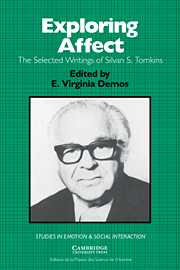Book contents
- Frontmatter
- Contents
- Foreword
- Editor's preface
- List of contributors
- Chronology
- Introduction
- Part I Affect theory
- Introduction
- Selections by Silvan S. Tomkins
- Part II Affect and ideology
- Introduction
- Selections by Silvan S. Tomkins
- Part III The face of affect
- Introduction
- Selections by Silvan S. Tomkins
- Part IV Script theory: The differential magnification of affect
- Introduction
- Selections by Silvan S. Tomkins
- Part V Human being theory: A foundation for the study of personality
- Introduction
- Selections by Silvan S. Tomkins
- The cognitive system
- Simulation of personality: The interrelationships between affect, memory, thinking, perception, and action
- Personality theory and social science
- A complete annotated bibliography of Silvan S. Tomkins's writings
- References
- Author index
- Subject index
- Titles in the series
Personality theory and social science
Published online by Cambridge University Press: 10 November 2010
- Frontmatter
- Contents
- Foreword
- Editor's preface
- List of contributors
- Chronology
- Introduction
- Part I Affect theory
- Introduction
- Selections by Silvan S. Tomkins
- Part II Affect and ideology
- Introduction
- Selections by Silvan S. Tomkins
- Part III The face of affect
- Introduction
- Selections by Silvan S. Tomkins
- Part IV Script theory: The differential magnification of affect
- Introduction
- Selections by Silvan S. Tomkins
- Part V Human being theory: A foundation for the study of personality
- Introduction
- Selections by Silvan S. Tomkins
- The cognitive system
- Simulation of personality: The interrelationships between affect, memory, thinking, perception, and action
- Personality theory and social science
- A complete annotated bibliography of Silvan S. Tomkins's writings
- References
- Author index
- Subject index
- Titles in the series
Summary
The major questions to which I will address myself are these: how interdisciplinary should we be – and why, or why not? How similar are the physical, biological, psychological and social systems? Can we tell without looking? How long should we look? Where should we look? Is there any reasonable basis for looking at this time for unifying concepts?
Clearly the fact is that societies are composed of human beings and these are composed of tissues, muscles, bones, nerves and blood and these in turn are composed ultimately of elementary particles. This would not at once evoke any enthusiasm for a hyphenated research or training program entitled “Elementary Particle–Comparative Social Systematics.” The fact that a man will fall through space at 32 feet per second is true but uninteresting as a basis for interdisciplinary concern. If man was not created in the image of one university department, neither would he be equally at home in any and all departments.
Coexistence versus independence of states
Let us examine at the outset some of the more obvious differences between biological, psychological and social systems. As a biological entity, man is not only differentiated but his separate characteristics have markedly different developmental histories. The familiar logistic growth curve is found more often in textbooks than in man. Consider first a characteristic which is roughly fitted by such a developmental curve – height.
- Type
- Chapter
- Information
- Exploring AffectThe Selected Writings of Silvan S Tomkins, pp. 468 - 480Publisher: Cambridge University PressPrint publication year: 1995



